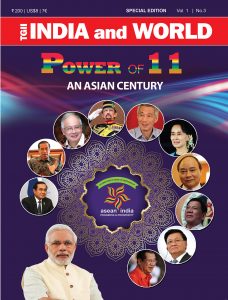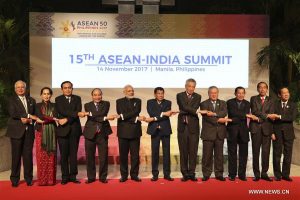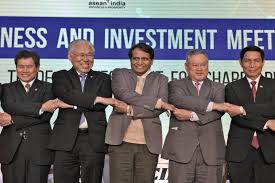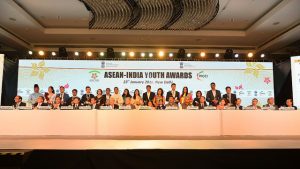
The soaring dream of an Asian Century is poised to acquire new wings as the leaders of India and 10 ASEAN countries participate in a special commemorative summit in New Delhi, marking the silver jubilee anniversary of their multi-faceted partnership. In a captivating spectacle, the 10 ASEAN leaders will also be Guests of Honour at India’s Republic Day celebrations on January 26, 2018, the first time the leaders of a region have been bestowed such a singular honour by New Delhi, underscoring the increasing salience of the region in India’s foreign policy calculus.
In many ways, it’s time for multiple celebrations for India and ASEAN, which are conjoined by “Shared Values, Common Destiny” – the master-theme of the summit, as they toast the 25th anniversary of their dialogue partnership, 15 years of summit-level interaction and 5 years of Strategic Partnership. The intersection of the golden jubilee of the establishment of ASEAN and the silver jubilee of India-ASEAN partnership has only heightened a sense of festivity and pride in what has been achieved so far and what’s yet to come.
While celebrations are in order, the silver jubilee anniversary is an apt time for India and ASEAN to retrospect, introspect and map the way ahead for this mutually empowering and enriching partnership that can visibly transform the lives of over 1.8 billion people living in the fastest growing region in the world.
Looking Back
Looking back, it’s been an exhilarating journey, with many milestones on the way, starting with the launch of India’s ‘Look East’ policy in 1992 and its transformation into Act East policy in November 2014 under the watch of the Narendra Modi government. The achievements have been substantive and myriad: India-ASEAN trade has multiplied manifold to around $75 billion and the two sides have forged a multi-dimensional strategic partnership which entails proactive cooperation on a range of cross-cutting issues, including terrorism, piracy, global governance, sustainable development and proliferation.
3Cs
Pivoted around the three pillars of Commerce, Connectivity and Culture, India-ASEAN partnership has branched out in diverse areas touching people’s lives. The relationship is moving from Government-to-Government (G2G) and Business-to-Business (B2B) to forge a sturdier People-to-People (P2P) bridge. Innovation, Creativity and Entrepreneurship are emerging as new pillars of the multi-hued India-ASEAN partnership. This was reflected in a wide array of events held to celebrate the interlinked destinies and intertwined dreams of the people of the two regions. Ranging from music shows, an art camp and textile exhibitions to a youth summit, start-up fest and dialogue of ideas, these events showcased the widening canvas of the India-ASEAN partnership.
Raising the Bar

There is, therefore, a lot to rejoice in, but these celebrations need to be sobered by a growing perception of the gap between ringing declarations and delivery and the long journey that still lies ahead to optimise the potential of the India-ASEAN relationship. Against this backdrop of an unfolding narrative of conjoined resurgence of India and ASEAN and the arc of prosperity that underpins this multi-layered relationship, India and World has dedicated a special edition on the burgeoning India-ASEAN partnership which is looking to scale new frontiers in days to come. This special edition of India-ASEAN@25 brings together eminent diplomats, experts and veteran region watchers from India and ASEAN countries to take an imaginative and critical look at shared values that bind India and ASEAN and unfolding opportunities to push the envelope and actualise the common destiny.
To get to the common destiny, there are enormous challenges that the two sides need to address urgently. First and foremost, with the business of diplomacy becoming increasingly business, the overarching thrust will be on deepening and diversifying economic relationship. The signing of an FTA in Goods and services was a milestone, but more needs to be done to optimise this potentially transformational agreement. If recent trends are anything to go by, the two sides need to redouble efforts and make concerted policy changes to leverage their mutual economic upswing to scale up bilateral trade to $200 billion by 2022. In this regard, the India-ASEAN FTA in services need to be ratified promptly by the remaining hold-outs.
 Secondly, major connectivity projects, including the India-Myanmar-Thailand Trilateral Highway and Kaladan Multi-Modal Transit Transport Corridor, need to be fast-tracked to bolster India’s credentials as a reliable provider of quality infrastructure and connectivity projects. Enhanced connectivity, in particular, will be a potential game-changer for stimulating economic resurgence of India’s Northeast states. Northeast’s “geographical location makes it the obvious gateway to India, linking the vast economies of the Indian subcontinent and of today’s ASEAN countries,” said India’s President Ram Nath Kovind at the Northeast Development Summit in November.
Secondly, major connectivity projects, including the India-Myanmar-Thailand Trilateral Highway and Kaladan Multi-Modal Transit Transport Corridor, need to be fast-tracked to bolster India’s credentials as a reliable provider of quality infrastructure and connectivity projects. Enhanced connectivity, in particular, will be a potential game-changer for stimulating economic resurgence of India’s Northeast states. Northeast’s “geographical location makes it the obvious gateway to India, linking the vast economies of the Indian subcontinent and of today’s ASEAN countries,” said India’s President Ram Nath Kovind at the Northeast Development Summit in November.
Balancing Games
Looking ahead, the real challenge will be, however, in the strategic arena. Amid the mutating geopolitical landscape and shifting equations in the region, marked by the inexorable rise of China and signs of retreat from the US, there is a renewed quest for a credible balancing power in the region. Many years ago, Singapore’s elder-statesman Lee Kuan Yew had argued eloquently that India must be “part of the Southeast Asia balance of forces” and “a counterweight [to China] in the Indian Ocean.” Now, many key ASEAN countries are looking at India as a balancing power. Can India step up to the plate, and play a bigger role, in partnership with ASEAN, in shaping an open, balanced and inclusive regional order? The appetite is clearly there, but it needs to be backed by a coherent strategic vision of regional security architecture, without getting embroiled in zero sum games and polarising games of containment. In their interview with India and World, the ambassadors of Vietnam and Indonesia have pitched for a bigger role for India amid the evolving geopolitical dynamics in the ASEAN region.
Power of 11
 In a recent book, Kishore Mahbubani and Jeffery Sng have glowingly termed “The ASEAN Miracle” as “A Catalyst for Peace.” This description can be applied aptly to the blossoming India-ASEAN relations as the 11 countries, bound by convergent interests, and with a combined GDP of over $5 trillion, come together with a renewed sense of mission to shape an ongoing Asian renaissance.
In a recent book, Kishore Mahbubani and Jeffery Sng have glowingly termed “The ASEAN Miracle” as “A Catalyst for Peace.” This description can be applied aptly to the blossoming India-ASEAN relations as the 11 countries, bound by convergent interests, and with a combined GDP of over $5 trillion, come together with a renewed sense of mission to shape an ongoing Asian renaissance.
Call it “The Power of 11,” if you will. In numerology, the number 11 is called a ‘master’ number that betokens new beginnings and represents higher ideals, invention, refinement, congruency, balance, fulfilment and vision. Number 11 has a master vibration and should not be reduced to a single number. One may be sceptical of all this mumbo-jumbo, but these ideals show the way as India and ASEAN map the next eleven years of their partnership and beyond by dovetailing their growth story to co-script an action-oriented agenda for fructifying an Asian Century.
 (Manish Chand is Founder-CEO of TGII Media Private Limited, a leading media, publishing and research/consultancy company, and India Writes Network (www.indiawrites.org). He is the publisher and Editor-in-Chief of “India and World,” a pioneering magazine focused on international affairs and India’s expanding global engagements)
(Manish Chand is Founder-CEO of TGII Media Private Limited, a leading media, publishing and research/consultancy company, and India Writes Network (www.indiawrites.org). He is the publisher and Editor-in-Chief of “India and World,” a pioneering magazine focused on international affairs and India’s expanding global engagements)
— To subscribe to India and World magazine, write to editor@indiawrites.org, indiaandworld@hotmail.com
Author Profile

- Manish Chand is Founder-CEO and Editor-in-Chief of India Writes Network (www.indiawrites.org) and India and World, a pioneering magazine focused on international affairs. He is CEO/Director of TGII Media Private Limited, an India-based media, publishing, research and consultancy company.
Latest entries
 India and the WorldMarch 3, 2024India-Denmark Connect: Red carpet for Indians to Red Sea cooperation
India and the WorldMarch 3, 2024India-Denmark Connect: Red carpet for Indians to Red Sea cooperation India and the WorldFebruary 17, 2024Munich Security Conference: Jaishankar, Blinken focus on Red Sea, Middle East
India and the WorldFebruary 17, 2024Munich Security Conference: Jaishankar, Blinken focus on Red Sea, Middle East India and the WorldFebruary 14, 2024Munich Security Conference report: Migration, war top security threats
India and the WorldFebruary 14, 2024Munich Security Conference report: Migration, war top security threats India and the WorldJanuary 23, 2024With “Ram to Rashtra” mantra, Modi consecrates Ram temple for national renewal
India and the WorldJanuary 23, 2024With “Ram to Rashtra” mantra, Modi consecrates Ram temple for national renewal







